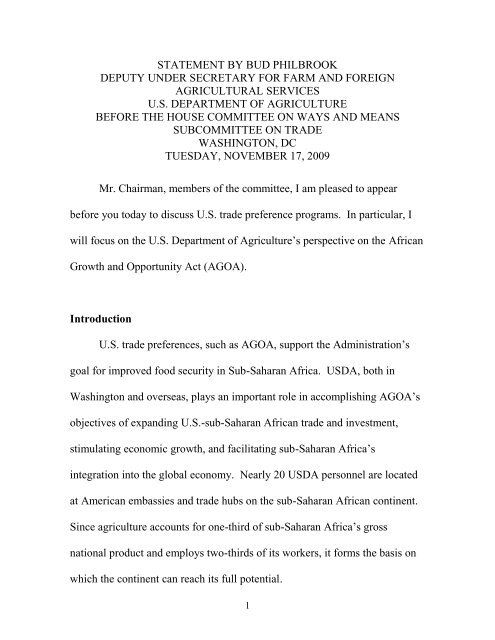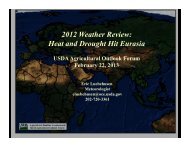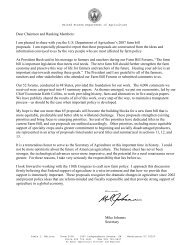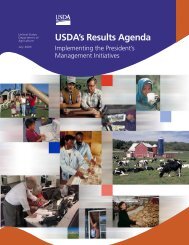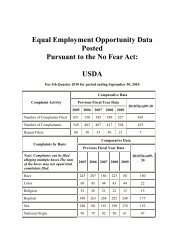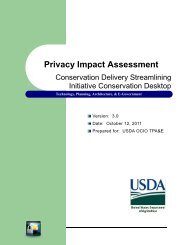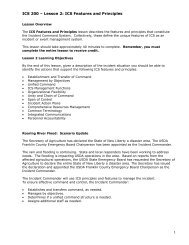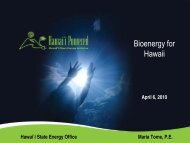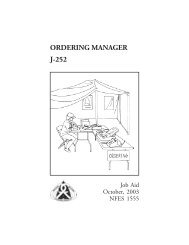USDA's Perspective on the African Growth and Opportunity Act ...
USDA's Perspective on the African Growth and Opportunity Act ...
USDA's Perspective on the African Growth and Opportunity Act ...
You also want an ePaper? Increase the reach of your titles
YUMPU automatically turns print PDFs into web optimized ePapers that Google loves.
STATEMENT BY BUD PHILBROOKDEPUTY UNDER SECRETARY FOR FARM AND FOREIGNAGRICULTURAL SERVICESU.S. DEPARTMENT OF AGRICULTUREBEFORE THE HOUSE COMMITTEE ON WAYS AND MEANSSUBCOMMITTEE ON TRADEWASHINGTON, DCTUESDAY, NOVEMBER 17, 2009Mr. Chairman, members of <strong>the</strong> committee, I am pleased to appearbefore you today to discuss U.S. trade preference programs. In particular, Iwill focus <strong>on</strong> <strong>the</strong> U.S. Department of Agriculture’s perspective <strong>on</strong> <strong>the</strong> <strong>African</strong><strong>Growth</strong> <strong>and</strong> <strong>Opportunity</strong> <strong>Act</strong> (AGOA).Introducti<strong>on</strong>U.S. trade preferences, such as AGOA, support <strong>the</strong> Administrati<strong>on</strong>’sgoal for improved food security in Sub-Saharan Africa. USDA, both inWashingt<strong>on</strong> <strong>and</strong> overseas, plays an important role in accomplishing AGOA’sobjectives of exp<strong>and</strong>ing U.S.-sub-Saharan <strong>African</strong> trade <strong>and</strong> investment,stimulating ec<strong>on</strong>omic growth, <strong>and</strong> facilitating sub-Saharan Africa’sintegrati<strong>on</strong> into <strong>the</strong> global ec<strong>on</strong>omy. Nearly 20 USDA pers<strong>on</strong>nel are locatedat American embassies <strong>and</strong> trade hubs <strong>on</strong> <strong>the</strong> sub-Saharan <strong>African</strong> c<strong>on</strong>tinent.Since agriculture accounts for <strong>on</strong>e-third of sub-Saharan Africa’s grossnati<strong>on</strong>al product <strong>and</strong> employs two-thirds of its workers, it forms <strong>the</strong> basis <strong>on</strong>which <strong>the</strong> c<strong>on</strong>tinent can reach its full potential.1
AGOA SuccessesUSDA is committed to providing capacity building, technicalassistance <strong>and</strong> training, <strong>and</strong> research programs that will enhance Africa’sability to trade in agricultural products. This assistance has c<strong>on</strong>tributed to a$100-milli<strong>on</strong> increase in exports of agricultural products – including n<strong>on</strong>traditi<strong>on</strong>al<strong>and</strong> value-added products – from Sub-Saharan countries to <strong>the</strong>United States since 2001, AGOA’s first full year of implementati<strong>on</strong>. Productsimported include fruits <strong>and</strong> nuts, coffee <strong>and</strong> tea extracts, wines, fruit juices,cocoa products, prepared vegetables, cut flowers, <strong>and</strong> prepared seafood.Before we can permit <strong>the</strong> import of agricultural products into <strong>the</strong>United States from any country, our Animal <strong>and</strong> Plant Health Inspecti<strong>on</strong>Service (APHIS) must complete an extensive analysis of <strong>the</strong> pest <strong>and</strong> diseaserisks associated with those products <strong>and</strong> determine if <strong>and</strong> how those risks canbe mitigated to allow for safe importati<strong>on</strong>. Under <strong>the</strong> AGOA initiative,APHIS has completed several pest risk analyses from potential tradingpartners in sub-Saharan Africa. To simplify <strong>and</strong> expedite <strong>the</strong> regulatoryprocess for approving new fruit <strong>and</strong> vegetable imports <strong>and</strong> pest-free areas,APHIS published a final rule in July 2007 that has been used to expedite <strong>the</strong>imports of several types of agricultural products including those from Africa,2
while still providing pest risk assessments for public comment. This newprocess has been used to allow <strong>the</strong> import of products such as baby carrots<strong>and</strong> baby corn from Kenya; currants <strong>and</strong> gooseberries from South Africa; <strong>and</strong>peppers, eggplant, <strong>and</strong> okra from Ghana. We have also permitted <strong>the</strong> importof certain commodities under our traditi<strong>on</strong>al approval system, includingblueberries from South Africa; <strong>and</strong> baby squash from Zambia.However, it is important to note that, even if APHIS determines that <strong>the</strong>pest <strong>and</strong> disease risk associated with <strong>the</strong> import of <strong>the</strong>se products can beappropriately mitigated, this does not mean that export of <strong>the</strong>se products to<strong>the</strong> United States will begin immediately. USDA efforts at analyzing risk <strong>and</strong>granting import approvals are more effective if infrastructure is in place totake advantage of exporting opportunities. A country or industry may nothave <strong>the</strong> ability to take <strong>the</strong> steps needed to mitigate <strong>the</strong> pest <strong>and</strong> disease riskassociated with its products, or may not have <strong>the</strong> transportati<strong>on</strong> or marketinginfrastructure in place. For example, APHIS approved <strong>the</strong> import of peppers<strong>and</strong> eggplant from Ghana; however, <strong>the</strong> country’s irradiator is not currentlyfuncti<strong>on</strong>al. Ghana needs to overcome this technological hurdle to treat fruits<strong>and</strong> vegetables to mitigate pest <strong>and</strong> disease risk.Recognizing <strong>the</strong>se challenges, USDA, working in c<strong>on</strong>cert with <strong>the</strong> U.S.Agency for Internati<strong>on</strong>al Development (USAID), c<strong>on</strong>tinues to assist <strong>African</strong>3
host countries in streng<strong>the</strong>ning <strong>the</strong>ir sanitary <strong>and</strong> phytosanitary (SPS)safeguarding capacity. Toge<strong>the</strong>r, USAID <strong>and</strong> USDA have positi<strong>on</strong>ed SPSadvisors at three USAID-funded Africa Trade hubs. These advisors workwith <strong>the</strong>ir <strong>African</strong> counterparts to implement SPS improvement activities thatare critical to building <strong>the</strong> instituti<strong>on</strong>al regulatory capacity necessary tofacilitate trade. In Swazil<strong>and</strong>, USDA supported <strong>the</strong> initiati<strong>on</strong> of a h<strong>on</strong>eybeepest surveillance program to meet requirements for regi<strong>on</strong>al trade. InMozambique, USDA <strong>and</strong> <strong>the</strong> Ministry of Agriculture collaborated to design<strong>and</strong> implement a nati<strong>on</strong>al fruit fly surveillance program that is required tomaintain market access for Mozambican fresh horticultural exports.Since AGOA was enacted, USDA has c<strong>on</strong>ducted training <strong>on</strong>phytosanitary issues for more than 35 sub-Saharan countries. USDA hasseveral flagship programs that provide technical training <strong>and</strong> researchopportunities for policymakers, scientists, private sector representatives,university professors, <strong>and</strong> o<strong>the</strong>r agricultural professi<strong>on</strong>als. These programsinclude <strong>the</strong> Cochran Fellowship Program, <strong>the</strong> Borlaug Internati<strong>on</strong>alAgricultural Science <strong>and</strong> Technology Fellowship Program, <strong>the</strong> FacultyExchange program, <strong>and</strong> <strong>the</strong> Scientific Cooperati<strong>on</strong> Research Program.Successes include a Cochran fellow who has doubled milk producti<strong>on</strong><strong>on</strong> his small Kenyan dairy farm <strong>and</strong> implemented marketing strategies that4
improved <strong>the</strong> prices he gets for milk, while also helping hundreds of fellowfarmers by c<strong>on</strong>ducting <strong>on</strong>-farm training <strong>and</strong> c<strong>on</strong>tributing to a farm radio talkshow. A woman Cochran graduate from South Africa now owns her owncompany <strong>and</strong> is leading industry efforts to improve product quality <strong>and</strong>exp<strong>and</strong> <strong>the</strong> range of soy food products throughout Sou<strong>the</strong>rn Africa.A successful Borlaug initiative is our public-private partnership with<strong>the</strong> World Cocoa Foundati<strong>on</strong>. This partnership helps cocoa producingcountries learn state-of-<strong>the</strong>-art modern producti<strong>on</strong> <strong>and</strong> processing techniquesto improve overall quality <strong>and</strong> increase exports of high quality cocoa <strong>and</strong>cocoa products worldwide. Currently, nine Borlaug fellows from six <strong>African</strong>countries are receiving training in organic producti<strong>on</strong> <strong>and</strong> marketingmanagement in <strong>the</strong> United States that will facilitate collaborati<strong>on</strong> between <strong>the</strong>U.S. organics industry <strong>and</strong> <strong>African</strong> producers, leading to increased incomes<strong>and</strong> improved food security for small-scale sub-Saharan <strong>African</strong> farmers.Recognizing <strong>the</strong> important role that women play in agricultural producti<strong>on</strong> inAfrica, USDA is hosting three <strong>African</strong> Borlaug Women in Science fellowswho are currently receiving water resource <strong>and</strong> livestock disease managementtraining at <strong>the</strong> University of Florida. This training will also help increaseincomes <strong>and</strong> promote food security.5
In additi<strong>on</strong>, USDA’s two food assistance programs—<strong>the</strong> Food forProgress (FFPr) <strong>and</strong> <strong>the</strong> McGovern-Dole Internati<strong>on</strong>al Food for Educati<strong>on</strong><strong>and</strong> Child Nutriti<strong>on</strong> (McGovern-Dole) Programs—c<strong>on</strong>tain unique, l<strong>on</strong>g-termdevelopmental aspects. Our FFPr program is benefitting 72,000 smallholderlivestock owners in Ethiopia by developing <strong>the</strong> animal feed industry throughactivities that streng<strong>the</strong>n feed distributi<strong>on</strong> channels <strong>and</strong> improve feedformulati<strong>on</strong> <strong>and</strong> manufacturing <strong>and</strong> feedlot management <strong>and</strong> forageproducti<strong>on</strong>. In Tanzania, <strong>the</strong> FFPr is empowering rural women entrepreneursby developing <strong>the</strong>ir leadership skills <strong>and</strong> providing micro-credit loans tha<strong>the</strong>lp <strong>the</strong>m increase <strong>the</strong>ir incomes, allowing <strong>the</strong>m to obtain better medicalservices, food <strong>and</strong> educati<strong>on</strong>. The McGovern-Dole program in Senegal hasextended health services to more than 58 maternal <strong>and</strong> child health sites invulnerable communities so that mo<strong>the</strong>rs, pregnant women, <strong>and</strong> childrenbenefit from health services in <strong>the</strong>ir villages.Administrati<strong>on</strong>’s Food Security StrategyAgriculture is not <strong>on</strong>ly a basis for achieving AGOA’s objectives, it is<strong>the</strong> heart of <strong>the</strong> Administrati<strong>on</strong>’s food security strategy. Achieving a foodsecureAfrica is a major goal of this Administrati<strong>on</strong>.6
The U.S. food security strategy is based <strong>on</strong> <strong>the</strong> principles laid out in <strong>the</strong>July 2009 G8 Joint Statement <strong>on</strong> Global Food Security. USG efforts must bel<strong>on</strong>g-term. As part of a whole of government approach under <strong>the</strong> leadershipof State <strong>and</strong> USAID, we are focusing <strong>on</strong> <strong>the</strong> entire spectrum of food securitybeginning with helping countries develop strategies to increase crop output byadopting <strong>the</strong> latest seed technology <strong>and</strong> l<strong>and</strong> management techniques,appropriately applying fertilizer, linking small producers to markets <strong>and</strong>streng<strong>the</strong>ning post-harvest infrastructure, as well as nati<strong>on</strong>al <strong>and</strong> regi<strong>on</strong>altrade <strong>and</strong> transportati<strong>on</strong> corridors.Our food security strategy employs a whole-of-government approach thatlinks all pertinent U.S. Government agencies toge<strong>the</strong>r <strong>and</strong> increasinglypartners in <strong>the</strong> private sector, n<strong>on</strong>-governmental, private-voluntary, <strong>and</strong>internati<strong>on</strong>al organizati<strong>on</strong>s, civil society, <strong>and</strong> <strong>the</strong> poor <strong>the</strong>mselves.USDA will use its resources to work with <strong>the</strong> U.S. Department of State<strong>and</strong> USAID to focus <strong>on</strong> three key principles of food security: availability,accessibility, <strong>and</strong> utilizati<strong>on</strong>. USDA is tapping into its network of U.S. l<strong>and</strong>grantuniversities, research instituti<strong>on</strong>s, extensi<strong>on</strong> experts, trade associati<strong>on</strong>s,private voluntary <strong>and</strong> n<strong>on</strong>-governmental organizati<strong>on</strong>s, <strong>and</strong> o<strong>the</strong>r n<strong>on</strong>-profitorganizati<strong>on</strong>s <strong>and</strong> private companies across <strong>the</strong> country to provide capacity7
uilding, technical assistance <strong>and</strong> training, <strong>and</strong> research <strong>and</strong> food assistanceprograms.C<strong>on</strong>clusi<strong>on</strong>The Administrati<strong>on</strong> is committed to assisting sub-Saharan Africa, <strong>and</strong>food insecure countries globally, to achieve food security. Full utilizati<strong>on</strong> ofAGOA trade preferences is a critical piece of <strong>the</strong> puzzle. USDA is striving toassist countries to develop <strong>the</strong> capacity to capitalize <strong>on</strong> <strong>the</strong> beneficial termsprovided by AGOA. I look forward to your comments <strong>and</strong> questi<strong>on</strong>s. Thankyou.8


